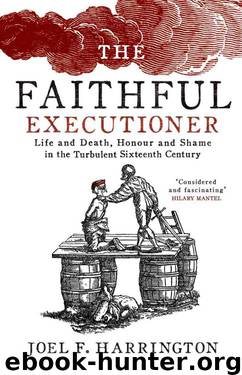The Faithful Executioner: Life and Death, Honour and Shame in the Turbulent Sixteenth Century by Harrington Joel F

Author:Harrington, Joel F. [Harrington, Joel F.]
Language: eng
Format: epub
Publisher: Random House
Published: 2013-05-01T23:00:00+00:00
A dastardly ambush of an innocent traveller by two robbers. Note the glee of the perpetrators and the fear of the victim (1543).
As in broadsheet accounts of crime, Frantz’s inclusion of descriptive details lent his stories dramatic verisimilitude, while simultaneously conveying the stark cold-bloodedness of the murderers. When a messenger was sent to collect a debt from Lienhard Taller (aka Spit Lenny), the farmer immediately handed over the payment and invited the servant to spend the night with him, sleeping on a bench in the parlour. While he was sitting and talking to him, [Taller] seized an axe from the wall and gave him two blows on the head, killing him immediately and taking back the money. Even more chillingly, the mercenary Steffan Stayner calmly stabbed [a companion] on the left side so that it came out on the right side, [then] afterwards cleaned off his foil before [the other] fell.6 One of Frantz’s most detailed accounts of an ambush juxtaposes the violence of the attack itself and the perpetrator’s ultimate punishment, thereby establishing the familiar equilibrium in cruelty that was the executioner’s mainstay:
Georg Franck from Poppenreuth, a smith’s man and a soldier, persuaded Fair Annala to let him escort her to meet Martin Schönherlin, her betrothed, at Bruck on the Leuth in Hungary. When he, with Christoph Frisch, also a mercenary, had brought her into a wood – the two having made a plot [about her] – Christoph struck her on the head with a stake from behind, so that she fell. [He] then dealt two more blows as she lay there. Franck also struck her once or twice and then cut her throat. They stripped her of everything except her shift and left her lying there, selling the clothes at Durn Hembach for 5 florins … Executed here with the wheel, first both arms, the third stroke on the chest, as decreed.7
In these and other ambushes, Schmidt consistently underscores that the evil deed was done with premeditation, with malice aforethought – a distinction also stressed by the legal codes and judges of the day.8 As in most societies today, legal authorities always deemed premeditated murder to be worse than simple manslaughter and accordingly punished it more harshly. The journeyman executioner is clearly appalled when the thief Georg Taucher murdered a tavern keeper’s son [during a break-in] at three o’clock in the morning … cutting his neck and throat, but the crime is made still more reprehensible in that it was done intentionally with a knife he carried about him for this purpose. Similarly, when Anna Strölin slew her own child, a boy of six years of age, with an axe, or Hans Dopffer stabbed and murdered his wife, who was very pregnant, Schmidt feels compelled to stress in each case that the shocking murder was committed with premeditation.9
For Meister Frantz, the ideal man was honest, pious, loyal, respectful, and brave. Calculating murderers, such as the patricide Frantz Seuboldt, represented the perfect inversion of this heroic type. It was
Download
This site does not store any files on its server. We only index and link to content provided by other sites. Please contact the content providers to delete copyright contents if any and email us, we'll remove relevant links or contents immediately.
| Belgium | France |
| Germany | Great Britain |
| Greenland | Italy |
| Netherlands | Romania |
| Scandinavia |
Room 212 by Kate Stewart(4121)
The Crown by Robert Lacey(4121)
Endurance: Shackleton's Incredible Voyage by Alfred Lansing(3858)
The Iron Duke by The Iron Duke(3657)
The Rape of Nanking by Iris Chang(3531)
Killing England by Bill O'Reilly(3467)
Joan of Arc by Mary Gordon(3272)
Say Nothing by Patrick Radden Keefe(3077)
I'll Give You the Sun by Jandy Nelson(2849)
Shadow of Night by Deborah Harkness(2747)
Hitler's Monsters by Eric Kurlander(2741)
Margaret Thatcher: The Autobiography by Thatcher Margaret(2691)
Mary, Queen of Scots, and the Murder of Lord Darnley by Alison Weir(2683)
Darkest Hour by Anthony McCarten(2655)
Blood and Sand by Alex Von Tunzelmann(2615)
Red Famine: Stalin's War on Ukraine by Anne Applebaum(2472)
Eleanor & Park by Rainbow Rowell(2402)
The One Memory of Flora Banks by Emily Barr(2357)
Book of Life by Deborah Harkness(2286)
